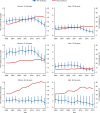Declines in HIV incidence among men and women in a South African population-based cohort
- PMID: 31792217
- PMCID: PMC6889466
- DOI: 10.1038/s41467-019-13473-y
Declines in HIV incidence among men and women in a South African population-based cohort
Abstract
Over the past decade, there has been a massive scale-up of primary and secondary prevention services to reduce the population-wide incidence of HIV. However, the impact of these services on HIV incidence has not been demonstrated using a prospectively followed, population-based cohort from South Africa-the country with the world's highest rate of new infections. To quantify HIV incidence trends in a hyperendemic population, we tested a cohort of 22,239 uninfected participants over 92,877 person-years of observation. We report a 43% decline in the overall incidence rate between 2012 and 2017, from 4.0 to 2.3 seroconversion events per 100 person-years. Men experienced an earlier and larger incidence decline than women (59% vs. 37% reduction), which is consistent with male circumcision scale-up and higher levels of female antiretroviral therapy coverage. Additional efforts are needed to get more men onto consistent, suppressive treatment so that new HIV infections can be reduced among women.
Conflict of interest statement
The authors declare no competing interests.
Figures




References
-
- UNAIDS. On the Fast-Track to end AIDS: UNAIDS 2016-2021 Strategy. https://www.unaids.org/sites/default/files/media_asset/20151027_UNAIDS_P... (2015).
-
- UNAIDS. UNAIDS Data 2017. http://www.unaids.org/sites/default/files/media_asset/20170720_Data_book... (2017).
-
- UNAIDS. Ending AIDS: progress towards the 90-90-90 targets. http://www.unaids.org/sites/default/files/media_asset/Global_AIDS_update... (2017).
-
- UNAIDS. UNAIDS Data 2018. https://www.unaids.org/en/resources/documents/2018/unaids-data-2018 (2018).
-
- UNAIDS. Miles to go: closing gaps, breaking barriers, righting injustices. https://www.unaids.org/sites/default/files/media_asset/miles-to-go_en.pdf (2019).
Publication types
MeSH terms
Substances
Grants and funding
LinkOut - more resources
Full Text Sources
Medical
Miscellaneous

